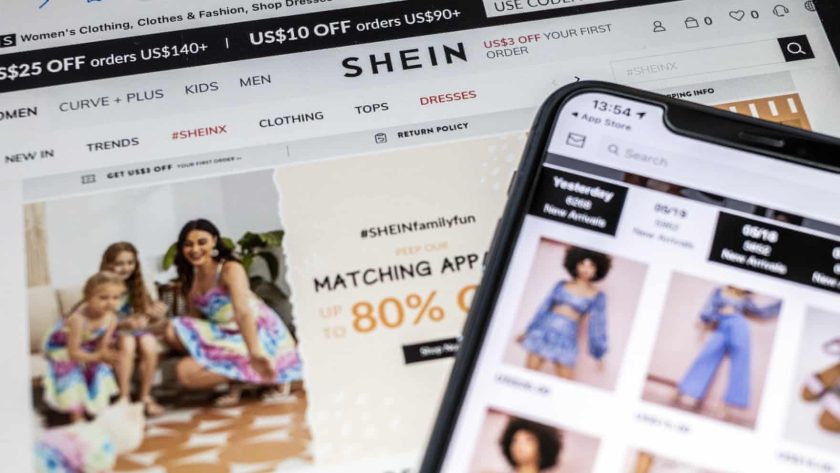Shein created a new era in ultra-fast shopping by connecting China’s garment factories to western gen-Z customers.
Julia King, a Texas 20-year old art student and influencer, noticed last year that a certain type of sweater vest was dominating the internet. Bella Hadid, among others, was photographed in shrunken, argyle-patterned styles. This style channeled classic 1990s films like Clueless, during the millennium-era nostalgia. King soon found the perfect pink-and-red knit vest for children in a secondhand store. It was snugly fitted and could be cropped to fit an adult. King used herself as a model and paired the vest with jeans and a Dior bag. King then snapped a photo and sold it on Depop, an app that is similar to eBay and popular among gen Z.
She sold the vest immediately and quickly forgot all about it. King received a message about a month later from one of her Instagram fans. They informed King that Preguy, an obscure Chinese shopping website, was selling a cheap replica of the thrift-store vest using King’s photo. King stated, “Seeing pictures of me on some random fast fashion website I’d never seen before made me really upset.”
Soon, replicas of the vest began appearing on numerous other clothing websites and e-commerce marketplaces like Amazon, AliExpress and Walmart. The image of King’s body would change over time. An awkwardly Photoshopped hand of another person was added to King’s torso.
Although retailers eventually started using their own photos for product photos, it didn’t make the experience less surreal. GadgetVLot, Weania and other unknown brands marketed their vests with confusing keywords such as “Autumn Preppy Style Streetwear Clothes,” or “Plaid Cotton Knitted Veget Elastic V-neck Sweater Crop.”
The vest, which was originally a vintage find, is now available to anyone for a much lower price. It had been stolen from social media and dropped into a frenzy of global e-commerce, as with many fashion trends. It was almost self-propagating in China’s growing ultra-fast fashion industry.

Over the past decade, hundreds of Chinese clothing companies have started selling online to international customers, bypassing traditional retailers who source their products from China. They are equipped with social media profiles in English, Amazon seller accounts and have access to flexible garment supply chains. This has accelerated the pace of fashion and filled closets all over the world with impossibly affordable clothes.
Rest of World, an independent, tech-focused journalism outlet, was based in New York for six months. They spoke with manufacturers, collected product data and social media, and made test purchases. Interviews were also conducted with shoppers and experts from the US and China. This reporting reveals how Chinese apparel manufacturers have developed to meet the needs of internet-savvy consumers and has changed their consumer habits. Companies such as Shein, the most well-known, financially secure and successful online retailer of its type, are capitalizing on this shift.
Although Shein is one of the largest fashion companies in the world, little is known about its history. SheInside was the company’s name when it was established in 2012. It reportedly started by selling wedding gowns abroad from its first headquarters, in Nanjing in China. Shein’s spokesperson denied that the company ever sold wedding gowns, but declined any other details. Although Chris Xu was born in China, the company’s founder is now a US citizen. However, a press release that referred to him as being from the US has since been deleted. Shein expanded its offerings to include apparel for men, women and children as well as home and pet products. However, the core business of Shein still sells clothes targeted at young women in their 20s and 30s. This is a generation that has grown up on social media platforms such as Instagram and Pinterest.
Shein’s clothing are not intended for Chinese customers. They are made for export. The company was the most downloaded shopping app on iOS and Android in May. It also topped the iOS rankings for more than 50 countries in May. It is second in popularity after Macys.com.
According to Bloomberg, Shein’s sales rose to $10bn (PS7.5bn) by 2020. This is a 250% increase over the previous year. The company was responsible for 28% of all US fast fashion sales in June – nearly as much as Zara and H&M combined. A report circulated in June that Shein was valued at more than $47bn. This made it one of the most valuable private startups in the tech sector. Shein declined to confirm the accuracy of the valuation or sales figures.
Shein’s rapid growth has created a number of controversies. Many designers claimed it stole their work. Brands such as Dr Martens and Levi Strauss sued Shein for trademark infringement. The former was paid an undisclosed amount, while Shein stated that it does not comment on ongoing litigation. It was also criticized for selling offensive or culturally sensitive products such as swastika neckties. Journalists and advocacy groups have found evidence that Shein’s $11 bikinis were made by workers in harsh conditions. Environmental experts also warned that these same items are often worn only once before being thrown away.
Shein’s aggressive business approach is at the core of these problems. It’s easy to compare Shein to H&M and other fast-fashion giants, but this is not the case. Shein operates an online marketplace that connects about 6,000 Chinese clothing factories. They are connected with proprietary software for internal management that provides near-instant feedback on which items are successful and which ones are not. This allows Shein to order new inventory almost as quickly as she needs. The software allows you to order designs – either original or based on existing products. The Shein head office in Guangzhou runs a polished advertising operation that is added to the design.
Shein works with its Chinese manufacturing partners to produce and test thousands of items at once. According to data gathered by Rest of World, the company added between 2,000 to 10,000 styles each day to its app between July and December 2021. According to the company, it orders a small quantity of each garment, sometimes a few dozen, then waits for buyers to respond. Shein orders more if the cropped sweater vest sells well. The system is described as a large-scale automated test-and-re-order (LATR), model.
Sheng Lu, a professor at The University of Delaware who studies the global textile and apparel industries, said that fast fashion is well-known for its frequent replenishment of product. “But Shein is completely different.” Lu’s research revealed that Shein offered 20 times more new products than Zara or H&M.
Shein’s success may have been aided by Amazon’s China activity. The e-commerce giant started recruiting Chinese manufacturers to sell their products overseas on its third-party marketplace in 2013. Western consumers became overwhelmed by thousands of new brands offering basic goods such as kitchen supplies and electronics chargers under unassuming names like Fretree, Nertpow and BSTOEM, as Chinese sellers began to join the platform.
These factories had the opportunity to eliminate western middlemen and learn about American consumers’ tastes. Amazon managed to lower the prices of its competitors and had 40% of its third-party vendors based in China by 2020.
The partnership between Amazon and Chinese manufacturers soon began to unravel. Amazon was facing customer complaints about dangerous and counterfeit products coming from China. In September 2018, Amazon banned hundreds of Chinese merchants who allegedly used fake product reviews. Amazon was not all that popular with sellers. They had to adhere to an ever-changing set of policies and pay high fees for services like order fulfillment and warehousing.
Du Tianchi, founder of an apparel business in China’s Jiangsu region that sells on AliExpress and Amazon, stated that “this cost is very high.” “Once you run out of stock in the US on Amazon, you will need to order new stock from China. This is expensive and time-consuming.”
Shein saw a chance to recruit many Chinese sellers to its platform, after they became increasingly frustrated with Amazon. Shein did not just compete with Amazon, it joined it. Amazon sells thousands of Shein’s products, some of which have been bestsellers.
Allison Malmsten, a China market analyst with Daxue Consulting, Hong Kong, said that Amazon “waved the appetite for online shopping and taught [Americans] how they can shop online and created the habit.” Shein realized that and decided to optimize it.
Shein did not try to copy Amazon, but instead brought the best of China’s gamified online e-commerce market to the rest. The country’s online shopping has become a form entertainment with livestreamers, flash sales, and tempting pop-ups that encourage customers to browse the latest products. Alibaba’s Taobao, an e-commerce platform in China, pioneered interactive features like custom product recommendations and built a mini social network within its app. Shein used similar components to its platform, including a points program that rewards customers for making purchases, reviewing and playing minigames.
Malmsten stated that Shein has learned much from the strategies of Chinese online e-commerce businesses. She said that Shein brought this style of shopping to the West, and it works well with Gen Z.
Seeing the rapid growth of the company, both major Chinese tech companies and startups are now trying to emulate it. ByteDance, Alibaba and others are also working on ecommerce platforms that target the same international audience as Shein. Cider, an e-commerce clothing brand from Hong Kong that is backed by Andreessen Horowitz, a Silicon Valley venture capital firm, is another example. The firm described Cider in a blogpost about its investment. It said that Cider is a “marketplace for global factories that makes users have more choice than Zara, at the price of Forever 21 on-demand”.
Lin Zhen, a Chinese clothing manufacturer, is the head of Amazon’s largest seller organization in Fujian. Fujian is one of China’s most important garment-producing provinces. Since 2011, Lin Zhen has been selling clothing directly to European and North American consumers. This was long before people started to use Instagram to purchase everything, from toothpaste to mattresses to toothpaste to Amazon. Lin’s clothing business, Xiamen Ouchengsheng (also known as OCS), now earns almost $100m annually in overseas sales, he revealed to Rest of World. About half of the sales came from Amazon this year. A third came from the company website. The rest came via AliExpress and other businesses including Shein.
Lin stated that Shein approached OCS initially because OCS was the most popular seller of dresses on AliExpress. Alibaba’s ecommerce platform for markets other than China. Lin explained that they were required to produce a specific number of styles each month and deliver them in as little time as possible. Lin said that the requirements were quite high.
Lin explained that Shein requires a variety of styles and that suppliers who have the ability to produce a wide range of products can work with Shein more easily.
Lin expressed his gratitude for Shein’s efforts in helping Chinese apparel sellers. Lin said that the company’s ability and willingness to endure a variety of difficulties, including worsening tensions with China and slowing global supply chains, a continuing pandemic, and increasing tensions between the US-China relations, is due to a “long-term vision” which included “meticulous supply management”.
Shein’s internal software is the key to its success. It connects all aspects of its business from design to delivery. Lin stated that “everything is optimized with big data.” Each supplier to Shein has their own account. You can view the sales and it will show you what to do if your product doesn’t sell. It all exists.
This software allows manufacturers to quickly execute new orders thanks to its simple design specifications. Lin said that a large brand may need a high-end designer or one with top technology. Even then, it might only be possible to produce 20-30 styles per month. Shein doesn’t have very high design requirements. A typical student at university could start designing quickly and produce a high-quality product.
Shein’s spokesperson declined to comment on the software but stated that the company is heavily involved in technology, training and support for its suppliers to make them more profitable and efficient.
European brands like Zara and H&M, have been championing fast fashion for years. This has reduced the time it takes to go from catwalk to shop window, from months to weeks. Shein doesn’t chase catwalk trends. Instead, Shein often copies items on Instagram and TikTok, where hype cycles are much faster. Zara asks manufacturers to deliver minimum orders of 2,000 items within 30 days. Shein, on the other hand, asks for 100 products within 10 days. Lu said that factories want to be more agile.
According to Sixth Tone, Chinese media outlet Sixth Tone, garment workers in China are under increasing pressure to produce clothes faster. They work long shifts in poorly controlled workshops and sew Shein products without rest. Rest of World was told by a Zhejiang factory operator that overtime in China’s garment industry is “a common occurrence”.
The worker said that, “Like many manufacturing industries in China,” overtime workers are already overworked.” He requested anonymity because they were not allowed to talk about their job publically. “It’s impossible for me to go to work between nine and five.” (The factory they work in doesn’t supply Shein, but it does produce clothes for other brands.)
Shein stated that the company takes all supply chain issues seriously and is committed to maintaining high labour standards in emailed comments. It stated that it will take “immediate actions” if it finds that a supplier is not adhering to its code.
Shein’s software-driven model lets it remain in complete control of the workers who make the products it sells. It can also avoid managing inventory directly for nearly all of its products, reducing the number of goods that remain unbought.
Shein needed to pay suppliers on time to convince them to join the system. According to Malmsten, a market analyst, receiving timely payments is a major problem for Chinese factories. She said that they have built loyalty with their suppliers so that they can be more urgent about their orders. Malmsten discovered that Shein’s website had more than 70% of its products listed within three months. This compares to 53% at Zara, and 40% at H&M. She said that Zara was blown out of the water by Shein.
Shein works with many factories simultaneously, but there is a drawback: Similar products are popping up everywhere on the internet. Lin, one of the suppliers, sells through multiple channels. This has led to consumers complaining on social media that similar clothes are appearing on Shein and AliExpress as well as Amazon, at different prices. These duplicated products often include basic items such as T-shirts or knockoffs from major fashion houses and independent labels. They don’t appear exclusive or unique so consumers can be swindled into paying more.
There are now communities on Facebook, Reddit, and TikTok where shoppers can share their tips on how to find similar-looking clothes at half the price or how to purchase a convincing “dupe,” a copycat of this season’s most popular designer handbag. TikTok users started to point out that a $16 crisscross top by Amazon was only $3.83 on AliExpress.
These forums result from an international shopping environment that has increased awareness of Chinese companies producing their clothes. Many people assume similar products originated in the same factory because they are aware that the majority of their purchases come from China.
Rest of World’s test purchases suggested otherwise. Rest of World purchased five pieces of clothing from five different online shopping sites in September 2021 (Cider, Shein, Amazon, Halara, Shop-Peche, AliExpress) had imitations of the same items. Although the items were often very similar, they weren’t all identical. This indicates that even though some suppliers may offer the same product on several websites, many apparel factories in China are skilled at copying each other and adapting to different trends.
Lu from the University of Delaware said, “Many of them are using data to predict what items they should make.” “If you use the exact same data inputs and the same algorithm, the results might be very similar.”
He said, “At many companies these days – including Shein – not the fashion guys are designing clothes.” “It’s engineers. Engineers looking at data.”
Two sweater vests were among the test purchases. They were both sold using Julia King’s Depop photograph: one from Amazon, one from AliExpress. The colours were not the same, even though they were made in the same manner. Two cherry-print cardigans with different designs from AliExpress and Shein had similar differences. Heart-print jeans from Cider and AliExpress differed in material and stitching. A pair of yellow platform shoes from Shop-Peche, a clothing brand that claims it was founded in New York, were not distinguishable from the AliExpress counterpart.
Marketing is key to a company’s success in a market where your products can be copied quickly by the competition. Shein has poured significant funds into Google and Facebook .advertising campaigns, influencer deals, and even its own social-media reality show co-hosted by Khloe Kardashian. Cooper Smith, an analyst in e-commerce and fashion who was previously the head of Amazon intelligence at Gartner, stated that they are spending massive amounts of money to attract consumers searching for products.
Shein’s strategy seems to be working: In August, the website received 150 million visits, 40% of which came via search according to Similarweb. This compares with just 4% for Zara’s. The company has partnered on social media with many micro-celebrities and fashion bloggers, as well as reality TV contestants. They show “haul” videos that show how trendy clothes are delivered to their followers via TikTok or Instagram. Before Shein’s app was banned by the Indian government last year, the company was at one point reportedly working with about 2,000 influencers in that country alone.
The Shein model established a new standard. The question is: Is it the norm that the clothing industry seeks? This company is a symbol of the fast fashion sector’s energy-intensive, high-tech manufacturing. It has also been known for using hazardous chemicals in its products that end up in landfills or oceans. Shein was appointed as the global head of environmental governance and social governance in November. The company informed Rest of World that it had implemented “water and waste management systems” and that it is currently working on an “expanded strategic plan”.
It is not clear how long ultrafast fashion’s environmental impacts can be ignored. Many experts raised concerns about the model’s long-term prospects. “Does Shein really need to be more established? Lu asked, “Is this really an exciting model to celebrate?”
However, new and more resourceful rivals are following closely. Alibaba, the pioneer of Taobao-style shopping, launched AllyLikes, its shopping site for North America, Europe and Asia in October. It looks almost identical to Shein’s site, with far fewer products and fewer reviews.
Rui Ma, founder of Tech Buzz China investment consulting firm and contributing columnist to Rest of World, stated that Alibaba could use its existing ecommerce expertise for this project. However, it is not clear how high it will be prioritized. ByteDance, meanwhile, is hiring for dozens of jobs related to international e-commerce, and a crop of other Chinese firms are trying to claim their own slice of the market, too.
This activity suggests that ultra-fast fashion will continue to increase in volume and speed as long as consumers continue buying into micro-trends and then discard them as quickly as possible.
StyleSage’s director of digital strategy and marketing, Elizabeth Shobert, said that “we are already in the race to find the cheapest product” and that the number of products is increasing. “I keep wondering: Where does it end?”
This article is based on the article by Rest of World.







